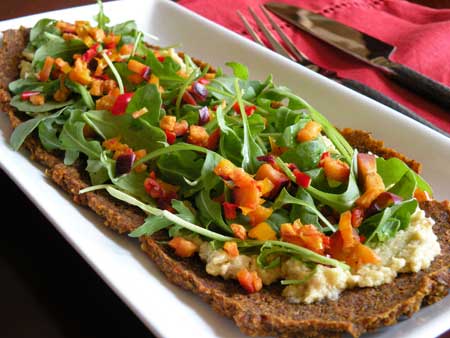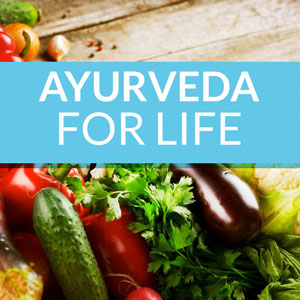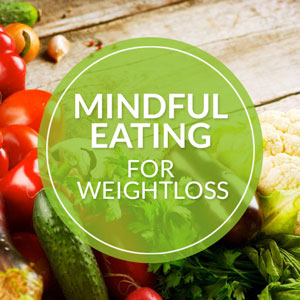Raw Food's Fat Lies: Can Raw Pizza be Worse Than Your Regular Slice?
Browsing Pinterest, you’re excited to find a recipe for a raw pizza, made with a nut crust and topped with nut cheese and vegetables. This may be a good substitute for the original gluten- and dairy-based version, but did you know that one slice of raw vegan pizza contains 36 g of fat and 416 calories? A slice of Domino’s cheese pizza, according to the Domino’s website, by comparison, contains 1.5-4.5 g of fat and 120-130 calories.
Many raw or vegan dishes are high in fat, salt, and contain an overabundance of seasoning. These foods can even be more difficult to digest than their traditional counterparts. A salad drenched in fatty dressing made using nuts can be just as difficult to digest as a salad served with ranch dressing.
According to Dr. Mark L. Vinick , a raw food diet is certainly high in enzymes, nutrients, and Prana, the energy of life. However, agni, the element of fire, which is increased via well-cooked food, is crucial for the proper digestion and absorption of nutrients into bodily tissues. In fact, Ayurveda recommends only consuming raw food for a short period of time, for detoxification purposes. Raw food increases the element of ether, or air, in the body, which can aggravate Vata. The cold, heavy, and salty qualities of raw nuts can lead to an increase in the Kapha dosha.
is increased via well-cooked food, is crucial for the proper digestion and absorption of nutrients into bodily tissues. In fact, Ayurveda recommends only consuming raw food for a short period of time, for detoxification purposes. Raw food increases the element of ether, or air, in the body, which can aggravate Vata. The cold, heavy, and salty qualities of raw nuts can lead to an increase in the Kapha dosha.
Of course, a vegan and raw food diet would rely on beans and nuts as a source of protein. However, eating too many nuts, which are raw and dry, will also be drying for the digestive system, causing the stomach to work overtime in an attempt to break down the nutrients for proper absorption. I have written about this subject in the past, explaining that nuts are dry and oily, which can aggravate all three doshas. The fat takes a long time to pass through the digestive tract, which results in difficult digestion and slow elimination. Consuming too many nuts can lead to nut sensitivity and a feeling of heaviness in the stomach.
But eating raw food is healthier than eating at a fast food joint, isn’t it?
We know that fast food joints serve unhealthy food that is processed and laden with chemicals, trans-fat, animal fat and is low in vitamins and minerals. However, not all food served in health food restaurants is as healthy for your digestion as you might think. Often vegan and raw foods are loaded with heavy fats and salt. While we need good fats, too much fats can slow down digestion and leave you feeling heavy and tired.
It never hurts to get your numbers straight so you can make an educated decision about what goes into your body. Let’s look at some major raw food restaurant favorites and just for the fun of it compare them to fast food dishes.
One Big Mac has 24 g of fat; an avocado contains 30 g. A large serving for french fries at McDonald’s contains only 25 g of fat, less than one avocado.
By comparison to the Big Mac, a raw vegan taco made mainly of walnuts and avocado, contains 51.4 g of fat:
Here are a few other infamously fatty dishes served in raw food restaurants, compared to their traditional counterparts:
Raw lasagna, marinated in olive oil and layered with nut cheese. In this recipe, one serving of raw lasagna contains 445 calories, 668 mg of sodium, and 39.5 g of fat. By comparison, this recipe for a traditional homemade lasagna, contains 288 calories, 783 mg of sodium, and 11 g of fat per serving:
Vegan nachos, made with flax crackers with guacamole, nut sour cream and salsa. According to this recipe, one serving of homemade vegan nachos contains 603 calories, 1,036 mg of sodium, and 38 g of fat. A serving of traditional nachos without meat, based on, contains 346 calories, 816 mg of sodium, and 18.95 g of fat.
Raw vegan pizza, made with a nut crust topped with nut cheese and a few vegetables. In this recipe, one serving contains 416 calories and 36 g of fat. A traditional homemade pizza with cheese contains 168 calories per serving and 6.1 g of fat, according to this recipe.
Animal fats are certainly very different from the fat content found in nuts. The bottom line is that of all the macronutrients, fats are toughest to digest. When we eat well-cooked (but not dry and overcooked) fresh meat, the stomach has an easier time digesting naturally occurring animal fat, as opposed to having to work to break down raw, dry nuts.
But what does this mean for those who follow a vegan diet and want to be mindful of the amount of fat they consume while still getting the nutrients the body needs?
The great news is that there are alternatives to the raw foods that are heavy in calories. You can make a lighter raw pizza by using cauliflower and a tiny bit of pre-soaked nuts to make the crust, or eliminate them altogether. Here is one basic recipe, which you can modify to make the pizza easier to digest.
Feel free to use less salt and fresh crushed garlic in lieu of the garlic powder. If you are going to consume nuts, be sure to soak them in water overnight and for up to 36 hours! Then, eat only a small handful (about 10 almonds) per day, chewing slowly to break down the food.
Next time you find yourself out at a dinner with friends at a raw restaurant, desperately trying to find something stomach-friendly and delicious, don’t be too hard on yourself. Enjoy your dinner! Feel free to order the nut crust pizza, but maybe skip the coconut oil and nut-based pudding for dessert. Most importantly, enjoy these foods mindfully, perhaps eating smaller portions, and return to your regular routine the following morning.











